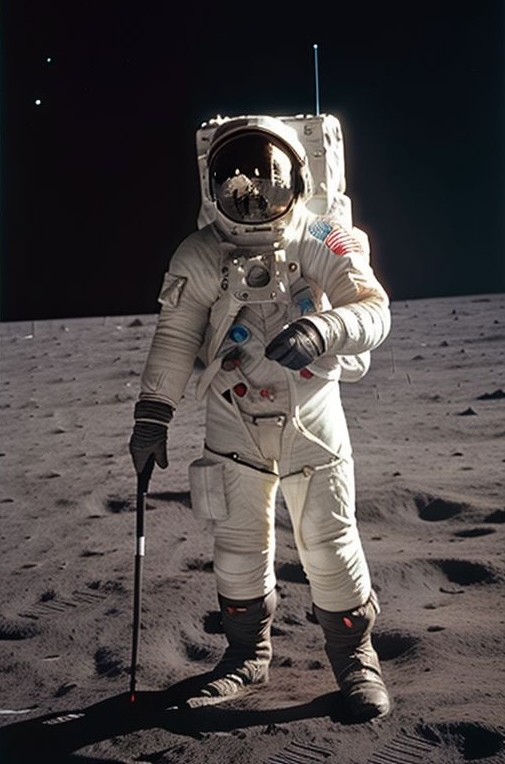This page is regularly updated to track progress on a project to research mountains and craters of the Moon, Mars (and more) with a prominence or depth of 1000 metres or more. The existing publication covering Earth is titled The Relative Mountains of Earth: The Ribus. The original working title for what is hoped to be a second publication was Relative Mountains of the Moon: Lunar Ribus but the project will include Mars too, and much more…so perhaps The Ribu Bagger’s Guide to the Solar System is more apt.
Latest update: 22/03/2025 by Daniel Quinn
———————————————————————-
22/03/2025:
Much has happened since January, with the web-app expanding to cover Ceres, Vesta and Mercury. Ceres appears to have approximately 120 Ribus. We are also compiling lists of craters with 1000 metres or more of depth, or anti-prominence. The Moon has over 10,000 of such craters, so due to space limitations our publication is likely to contain only the top 100 or so, with the complete list being available (eventually!) on this website as a database download.
As has been mentioned previously, the quality of data varies between celestial bodies, but we hope to publish comprehensive lists of Ribus for a moon (the Moon), a planet (Mars), a dwarf planet (Ceres) and an asteroid (Vesta) at the very least. Perhaps some introductory or provisional lists for Mercury and Venus.
The science writer and astronomer Jim Singh has joined the team, a fantastic addition given his great knowledge of, and passion for, the topography of other worlds. You can read his paper entitled ‘The Moon’s Highs and Lows’ here: https://moonsummits.carrd.co/
You can track our ongoing progress here: https://spaceribus.pythonanywhere.com/moon?
———————————————————————-
10/01/2025:
Work has been progressing really well on checking and naming Ribus on the Moon and Mars, though Mars has many peaks with no nearby named features to borrow from. We still have to decide where to set zero, as there is more than one option, so this will be decided a little later and may not necessarily follow the established method.
Looking at the quality of DEM data available, the dwarf planet Ceres and asteroid Vesta are both worth looking into too, though being much smaller than both the Moon and Mars the number or Ribus is likely to be in the hundreds rather than the thousands. More on this topic soon…
For now, you can track Martian Ribu research progress here: https://spaceribus.pythonanywhere.com/mars?
———————————————————————-
01/12/2024:
Oscar’s analysis is complete and his fantastic web-app for identifying, naming and researching Lunar Ribus is now up and running at the following address where you can track progress: https://spaceribus.pythonanywhere.com/moon?
I, Daniel, am now working through phase one of the editing process which is finding a plausible name for all of the Lunar Ribus and Sub-Ribus based on nearby existing officially-named features such as craters. Very few mountains on the Moon currently have a specific name so it is likely that they will mostly be derived from nearby named features with the addition of relevant prefixes such as ‘Mons’ as is part of the naming convention detailed at the Gazetteer of Planetary Nomenclature website. This may take some time… Currently, the approximate total of Lunar Ribus is 3597 plus 72 Lunar Sub-Ribus. A very rough first estimate of Martian Ribus suggests that Mars is home to approximately 3013 Ribus and 80 Sub-Ribus. So the total number of Ribus on the Moon and Mars added together is roughly 6610 (less than the total for Earth which is 7150).
———————————————————————-
28/10/2024:
An early preliminary test analysis of Lunar Ribus and Negative Ribus (craters) has been conducted by Oscar Argudo in order to provide a provisional expected size of the research project. He has found that there are likely to be very approximately 3000 Lunar Ribus (comfortably less than half of the 7150 Ribus found on Earth) and more than double that number of craters with a depth of 1000 metres or more (of which there are no known naturally-occurring examples on Earth but a handful of humanmade ones such as boreholes and mines). There are probably over 6500 craters on the Moon with a depth of 1000 metres or more.

The lunar surface
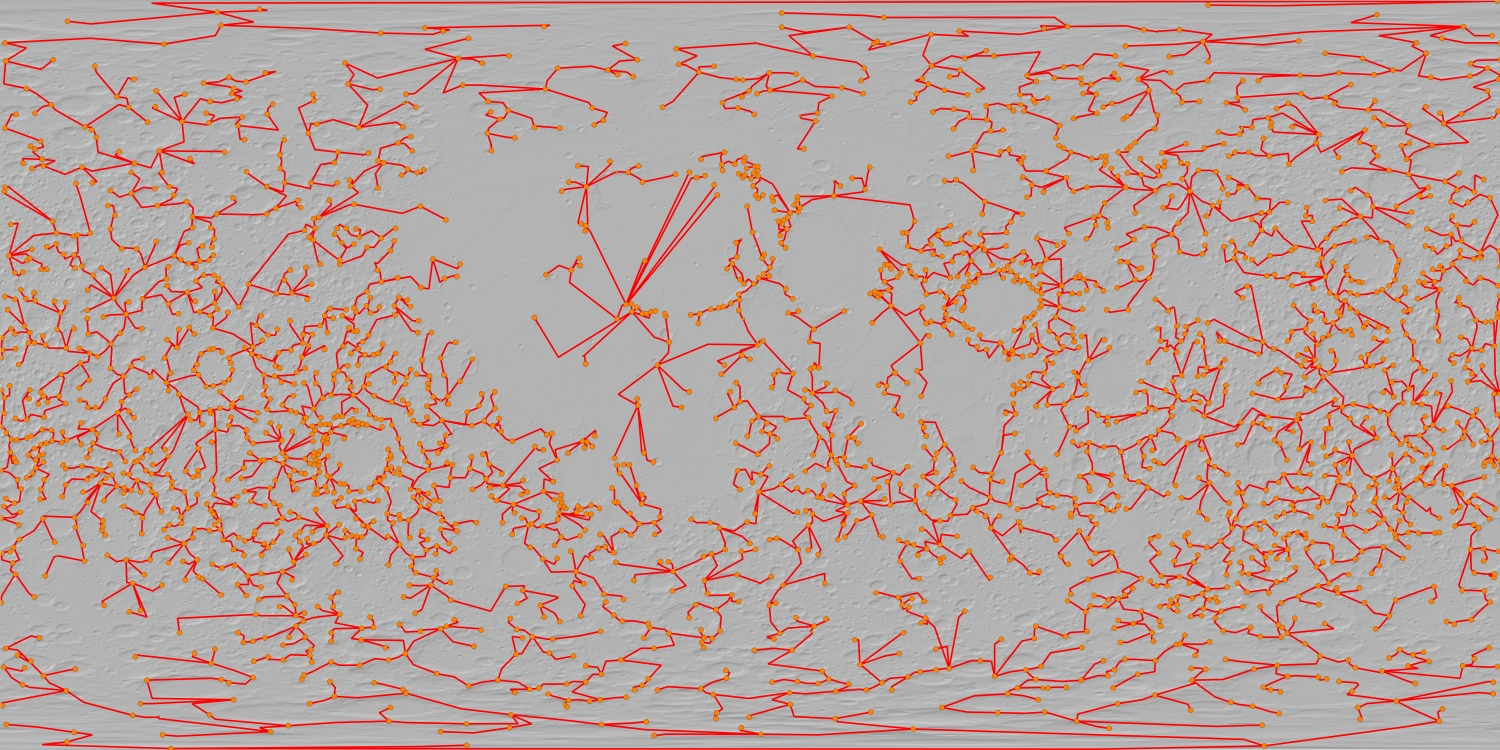
Preliminary analysis of Lunar Ribus (orange dot = P900 peak, red lines connect the peaks via the key cols)
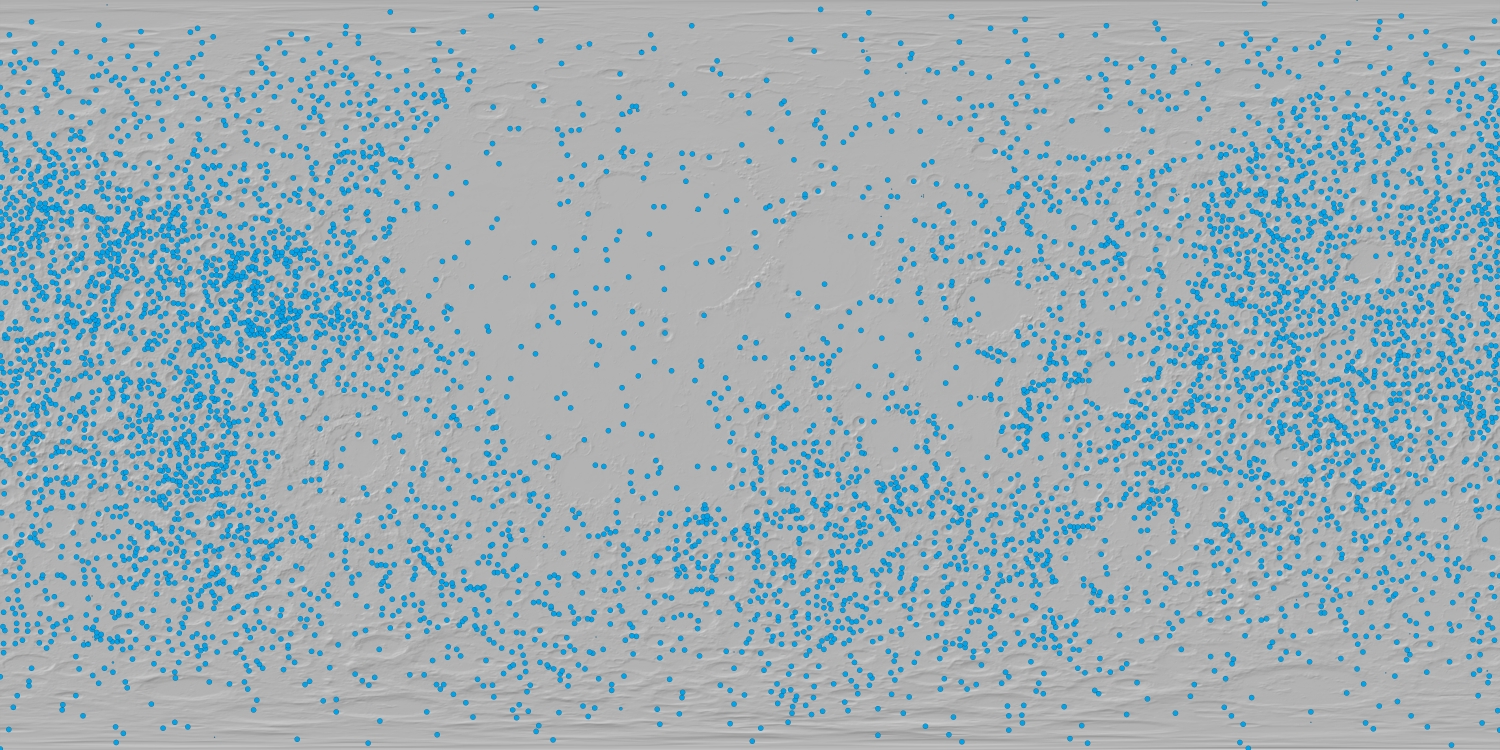
Preliminary analysis of Negative Ribus (blue dot = crater with depth of 900m or more)
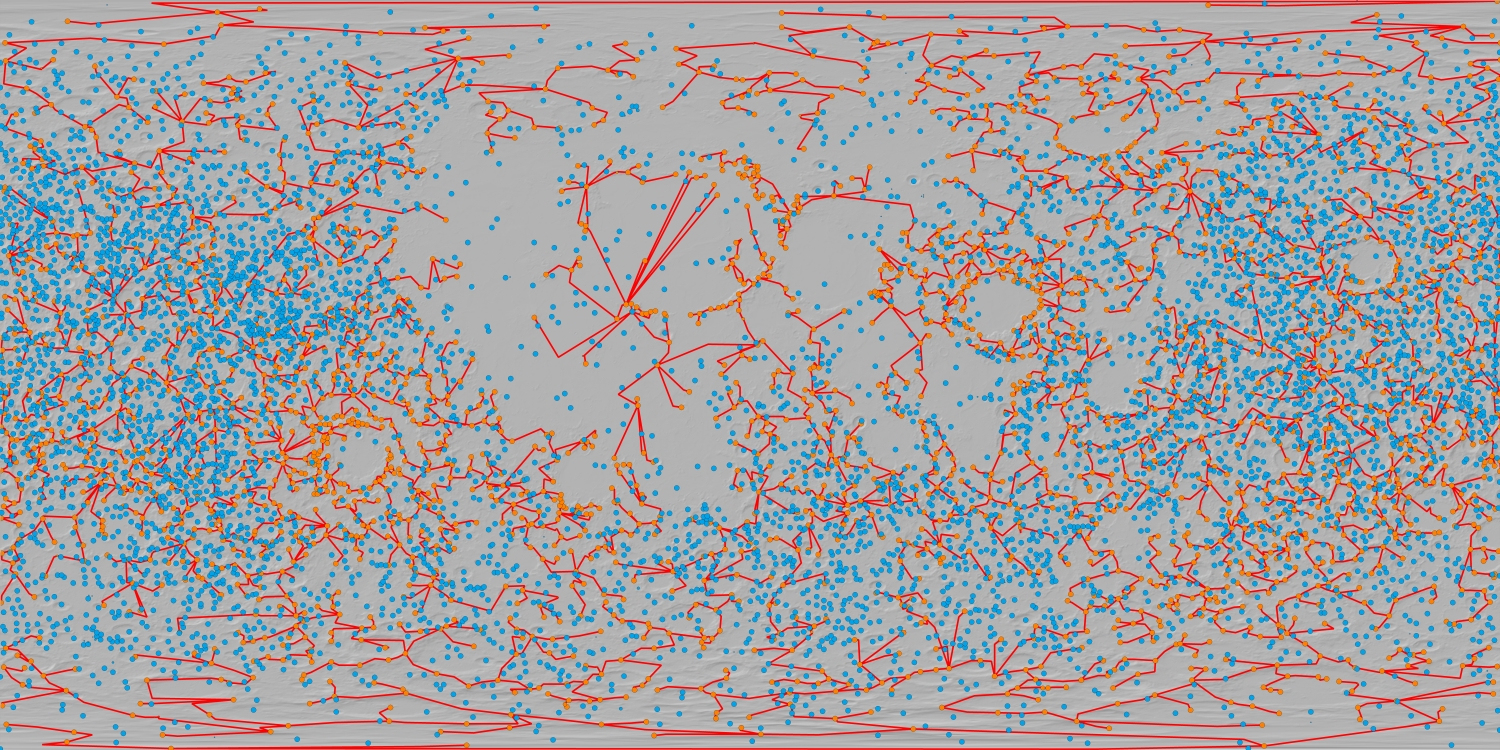
Preliminary analysis of Lunar Ribus and Negative Ribus – orange dots (P900 peaks) plus blue dots (craters with a depth of at least 900 metres)
This means the entire project will involve researching 10000 distinct lunar features, to take account of additional Sub-Ribus (P990-P999.9) that almost qualify as Ribus (P1000). 3000 Lunar Ribus plus 6500 craters plus at least 500 Lunar Sub-Ribus (negative and positive) equals 10000. It also means that approximately two-thirds of the entries in the Lunar Ribus database will be craters (negative) as opposed to mountains (positive).
As planned, the brief test was done using Andrew Kirmse’s code for analysing prominence in conjunction with the Lunar Orbiter Laser Altimeter digital elevation model from NASA / USGS.
On the same day I received an email from the Paul Hamlyn Foundation stating that I had not been successful in my application for funding for this project, primarily because it is viewed as academic research. Never mind. More soon.
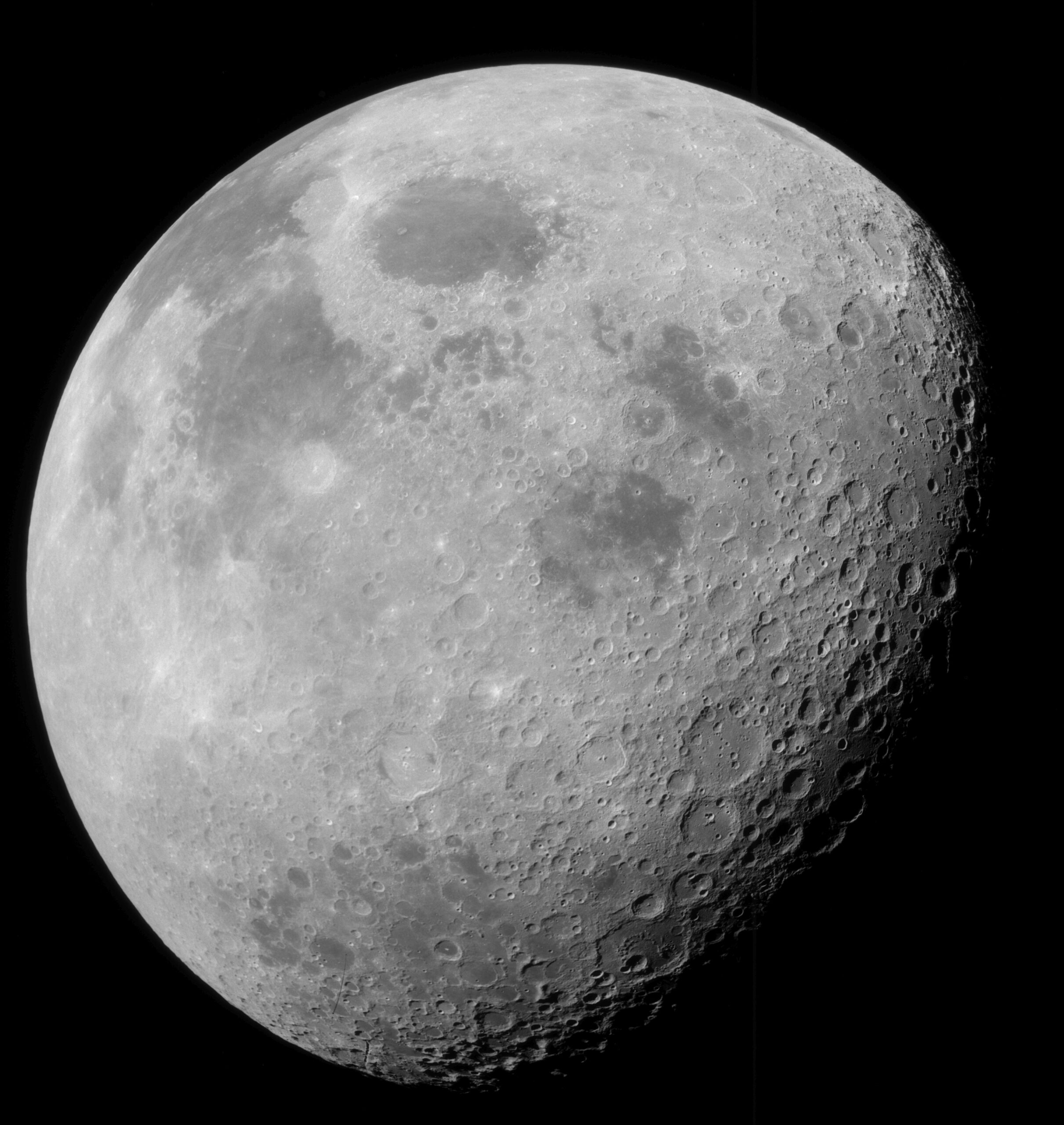
The Moon photographed during the Apollo 12 mission in November 1969.
———————————————————————-
05/10/2024:
Very early steps have been taken to commence a project to identify and name all of the Ribus on the Moon. This will include negative Ribus (craters with a depth of 1000 metres or more) and Lunar Sub-Ribus.
The project will begin in earnest towards the end of 2024 and most likely take a year to complete. I, Daniel Quinn, am looking for a data science student (or similar) who would be interested in working on this project. He or she needs to be capable of quite complex coding in order to create an online editing site with a representation of the Moon’s surface based on an available dataset. Plus lots of other stuff. At present there is no funding, but such a project would constitute a genuinely unique academic work. Depending on availability of time, co-authorship of a Lunar Ribus publication is up for grabs.
If you are interested in discussing this project in more detail please email dan@gunung.org
Dan, October 2024
